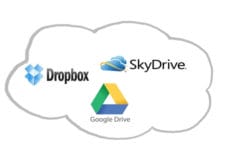Automatic Backup using Cloud Storage
One of my almost-famous sayings goes like this: “97% of people don’t bother to backup. But of the people who suffer a hard drive crash, 100% of them regret not doing so.” Everybody giving advice in technology says the same thing – backup your files. Yet almost nobody bothers to do this. Why? It’s too much work, too complicated, too hard, or takes too much time.
 So let me propose a simpler way to take care of this chore. Google users can install Google Drive on their PC or Mac. Or you can install and use Dropbox, Microsoft’s Skydrive, or any one of a number of vendors offering free or low-cost, online file storage services. In general, these programs work by creating a folder on your computer, and then synchronizing everything you put in that folder with an online copy that you can get to easily from just about any other computer or device. So it’s dead-simple to use.
So let me propose a simpler way to take care of this chore. Google users can install Google Drive on their PC or Mac. Or you can install and use Dropbox, Microsoft’s Skydrive, or any one of a number of vendors offering free or low-cost, online file storage services. In general, these programs work by creating a folder on your computer, and then synchronizing everything you put in that folder with an online copy that you can get to easily from just about any other computer or device. So it’s dead-simple to use.
 If you already have a google account (gmail, google +, etc.), then you already have access to Google Drive, you just need to visit the Google Drive page and download the app. Google Drive gives you 15gb of total storage space for free, you can bump this up to 100gb for $50/year from your google account settings page. You can use Google Drive on your Mac, PC, tablet and smartphone.
If you already have a google account (gmail, google +, etc.), then you already have access to Google Drive, you just need to visit the Google Drive page and download the app. Google Drive gives you 15gb of total storage space for free, you can bump this up to 100gb for $50/year from your google account settings page. You can use Google Drive on your Mac, PC, tablet and smartphone.
 If you prefer Dropbox, do likewise to install a program on your Mac, PC, tablet and smartphone. Dropbox gives you 5gb for free, more if you invite friends. And you can pay $50/year for 100gb of storage space.
If you prefer Dropbox, do likewise to install a program on your Mac, PC, tablet and smartphone. Dropbox gives you 5gb for free, more if you invite friends. And you can pay $50/year for 100gb of storage space.
 Microsoft Office users may prefer Skydrive, which is tied to your Microsoft Live account. You get 7gb for free, and can add 100gb for $50/year.
Microsoft Office users may prefer Skydrive, which is tied to your Microsoft Live account. You get 7gb for free, and can add 100gb for $50/year.
There are plenty of other players in the online file storage arena, but let’s just skip ahead to the trick we use to make automatic backup so easy:
Here’s the trick: Move all your files and folders into this new folder, keeping the same sub-folder arrangement that you had previously, e.g., documents, pictures, music, video, etc. Now, everything you have on your computer will be backed up automatically – no need to do anything else. If your computer goes belly-up and you have to replace it, all your personal files will be in the cloud and you can easily get them back onto a new computer. You can also access your files from any computer, anytime just by logging into the website for whichever service you’ve chosen.
If you use iTunes, you should update your library before you move all the files in your music folder – iTunes looks in a specific place for your library – so run iTunes and edit your preferences to move your library to the new location. You can then organize the library so all your music, movies, etc. are in the right place.
If you use Google Picasa, you should specify the new location of your Pictures folder inside Picasa either before or after you’ve moved them.
About security, since your files are ‘in the cloud’, they are subject to being compromised – it all depends on you using a good username/password combo. Do this and you really don’t need to worry, all these services have as good of security as anybody else these days. See this post for advice about creating a good password.
For many folks, the free space allocation is enough. But we find that for those of us with tons of digital photos and video, $99 a year is a relatively small price to pay to not have to worry about running out of space. You do get what you pay for (your $99 gets you 1 terabyte of space).
Lastly, for some folks who have tons and tons of files that would burst even 100gb in storage space, we think your best alternative at this point is a network storage drive (NAS). There are lots of them out there from companies like Synology, Drobo, and others that can handle whatever you can throw at them. This isn’t for everybody, but if you’re a file hound, you probably have the tech skills to deal with setting up and using an NAS.
This website runs on a patronage model. If you find my answers of value, please consider supporting me by sending any dollar amount via:
or by mailing a check/cash to PosiTek.net LLC 1934 Old Gallows Road, Suite 350, Tysons Corner VA 22182. I am not a non-profit, but your support helps me to continue delivering advice and consumer technology support to the public. Thanks!







